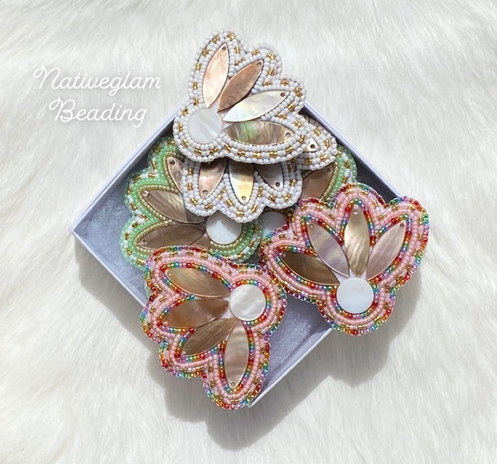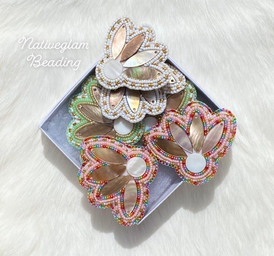Natasha Seymour was learning how to bead. Still a beginner in her traditional language, she couldn’t understand the directions, which were taught in Tahltan. Frustration arose as learning a new craft in a new language proved to be too difficult
“I couldn’t ask the questions that I needed to ask because I didn’t have the language in Tahltan to ask,” Seymour recalls. “We were beading on felt …and I didn’t get it at all.”
Last January, beading weaved its presence into Seymour’s life again with a visit from her sister. A co-worker from the high school she taught at gave the students a workshop on the practice, and her sister’s enthusiasm was just the nudge Seymour needed to give the craft one more shot.
Not wanting to curb her sister’s excitement, Seymour started to bead using a single needle technique. 15 minutes later, she couldn’t put it down. Fast forward about a year, Seymour is now a full-time beader and owner of Nativeglam, an online store whose Instagram page has over 6,000 followers. To Seymour, beading is not just a passion – it is a way to reclaim her culture and celebrate her Tahltan, Nisga’a and Tsimshian roots.

“I honestly feel like the day my sister brought the beading home, I was just blessed,” Seymour admits.
Indigenous beading holds great cultural significance in her life. According to a paper published by Malinda Joy Gray at the University of Toronto, beadwork is important for Indigenous artistic expression. Before colonialism, beads were made from natural resources like shells, claws, nuts and stone.
Beading itself was a slow and hard process; holes were made with a bone tool and handmade beads were strung together with animal sinew. Some archeologists have even speculated how beads might have acted as indicators of wealth.

Beading is now normally done with a needle and thread. Some patterns are stitched on felt fabric, while jewellery pieces, like earrings, can be done with just thread or epoxy cabs. There are also various stitching techniques, such as one needle and two-needle beading.
The biggest difference between the two styles is the number of beads that are strung on the thread and the way the needle loops through the beads to stitch them together. Various types of beads can be used and they range from glass to ceramic. Seymour likes to bead with abalone shells, which are important to her Tsimshian and Nisga’a heritage.
When asked about her favourite beading designs, Seymour said that she enjoys beading earrings.
“Shell florals are especially my favourite.” She adds that “the Tsimshian and Nisga’a nations had abalone for trade, so I really love working with shells.”

Gray’s research paper also states that when colonialism expanded to North America, Indigenous beadwork incorporated beads made from glass and fabric, such as coloured wool. Unlike Europeans, Indigenous people placed great cultural value on the practice; beading on articles of clothing was considered a gift of great importance, and beadwork on wampum belts could illustrate stories and be used for recording agreements between tribes, and later, treaties.
According to the Truth and Reconciliation Commission of Canada, when residential schools were created, articles of beaded clothing and any beadwork brought from home were often banned. The Truth and Reconciliation Commission states that beading is now integrated into healing programs for residential school survivors and their families to reconnect with “their cultures, languages, and communities.”
When asked about the importance of beadwork and where she gets her inspiration from, Seymour found it difficult to put it into words.
“I think it’s a spiritual process,” she simply explains.
Her sentiment is mirrored in many Indigenous cultures where beading often encompasses more than one meaning. Gray’s paper cites that beadwork can be passed down through the family or act as a symbol of kinship within a tribe.
“My great aunt Rose and my great aunt Caroline … they were very skilled beaders,” recalls Seymour. “Certain family members have been fortunate enough to receive gifts from them like mittens and hair barrettes.”
Nowadays, Gray makes note of how beadwork demonstrates the Indigenous people’s resilience to colonialism. Many designs and patterns have evolved to include both traditional Indigenous design and some modern symbols.
Indigenous-owned companies like Manitobah Mukluks use beadwork in their designs and have reached international recognition by using models like Kate Moss and Cindy Crawford. The company also has a Storyboot Project to revive the traditional art of making mukluks and moccasins through partnerships with elders and artisans. Other Indigenous-owned stores such as Kokom Scrunchies incorporate beading into hair accessories. Beadwork is also often stitched onto jackets, mittens and decorations.

Seymour’s Instagram bio reads “reclaiming my culture, one bead at a time.” The statement pays homage to her great aunts who have both passed away, as well as her grandmother who still beads.
Seymour is currently working on two beading collections and continues to make orders.
“I bead all day and all night. It’s all I do – my arms are sore, my hands are sore,” she laughs.
When I ask her if she still enjoys it despite her aching limbs, Seymour doesn’t hesitate for even a second.
“I absolutely do – it’s my passion.”


